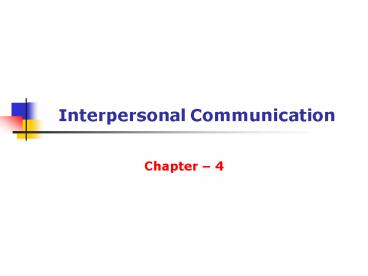Interpersonal Communication - PowerPoint PPT Presentation
1 / 21
Title:
Interpersonal Communication
Description:
Sender has two options after transmitting the message: ... Bulletin boards. Posters. Computers/e-mail. Fax. Chapter 4 Interpersonal Communication ... – PowerPoint PPT presentation
Number of Views:160
Avg rating:3.0/5.0
Title: Interpersonal Communication
1
Interpersonal Communication
- Chapter 4
2
Learning Objectives
- Explain why communication skills are important.
- List and explain the four steps in the
communication process. - List the three primary message transmission
media. - List the steps in the message-sending process.
- Explain how to give effective criticism.
3
Learning Objectives
- Explain three levels of listening.
- Describe how to be an active projective listener.
- Describe how to give and receive feedback.
- Explain six response styles and when to use each.
4
Defining Communication
- Communication the process of a sender
transmitting a message to a receiver with mutual
understanding. - Paraphrasing the process of having the receiver
restate the message in his or her own words.
5
Defining Communication
- Sender has two options after transmitting the
message - Assume the receiver understands (one-way
communication). - Check to see if the message has been understood
by - Questioning
- Encouraging responses and questions
- Paraphrasing
6
The Goals of Communication
- ...are to influence, inform, and/or to express
feelings. - Steps in the communication process
- 1. Select the transmission media.
- 2. Send the message. (Encoding)
- 3. Receive the message. (Decoding)
- 4. Respond to the message.
7
The Communication Process
8
The Goals of Communication
- Media the forms of the transmitted message
- Message is the physical form of the encoded
information. - Encoding is the senders process of putting the
message into a form that the receiver will
understand. - Decoding is the receivers process of
translating the message into a meaningful form
9
Transmission Media
- Oral communications
- Face-to-face
- Telephone
- Meetings
- Presentations
- Nonverbal communications
- Facial expressions
- Vocal qualities
- Gestures
- Posture
- Written communications
- Memos
- Letters
- Reports
- Bulletin boards
- Posters
- Computers/e-mail
- Fax
10
Sending Messages
- Planning the message
- WHAT is the goal of the message?
- WHO should receive the message?
- HOW will you encode the message?
- WHEN will you transmit the message?
- WHERE will you transmit the message?
11
Sending Messages
- Sending the Message, Face-to-Face
- Develop rapport.
- State the communication objective.
- Transmit the message.
- Check understanding.
- Get a commitment and follow up
12
Sending Messages
- Criticizing Others (Guidelines for Effective
Criticism) - Give more praise than criticism.
- Criticize immediately.
- Criticism should be performance oriented.
- (Task vs. Person)
- Give specific and accurate criticism.
- Open on a positive note and close by repeating
what action is needed.
13
Receiving Messages Levels of Listening
3. Projective The receiver listens without
evaluation to the full message, attempting to
understand the senders viewpoint.
2. Evaluative The receiver listens carefully
until hearing something that is not accepted.
Listening ends and the response to the incomplete
message is developed.
1. Marginal The receiver does not
listen carefully. The message is Not heard or
understood with mutual assent.
Empathic Listening The ability to understand and
relate to anothers situation and feelings.
14
Dealing with Emotional Employees
- Understanding feelings
- Feelings are subjective.
- Feelings are usually disguised as factual
statements. - Feelings are neither right nor wrong
15
Dealing with Emotional Employees
- Calming the emotional employee
- Never tell the employee that they shouldnt feel
the way they do. - Never chastise them for their feelings.
- Never tell them that you know how they feel.
16
Dealing with Emotional Employees
- Empathic listening
- Dont argue with the employee.
- Identify their feelings without agreeing or
disagreeing. - After dealing with emotions, go on to work on
content.
17
Projective Listening Tips
- Listening
- 1. Pay attention.
- 2. Avoid distractions.
- 3. Stay tuned in.
- 4. Do not assume and interrupt.
- 5. Watch for nonverbal cues.
- 6. Ask questions.
- 7. Take notes.
- 8. Convey meaning.
18
Projective Listening Tips
- Analyzing
- Think.
- Evaluate after listening.
- Evaluate facts presented.
- Speaking
- Paraphrase first.
- Watch for nonverbal cues.
19
Responding to Messages
- Feedback the process of verifying messages.
- Type of feedback
- 360 degree feedback (downward-supervisor,
laterally-peers, upwards-subordinates,
inwards-person with feedback. - Guidelines for obtaining feedback
- Be open to feedback
- Be aware of nonverbal communication
- Ask questions
- Paraphrasing
20
Response Styles
- Response Description
Appropriate Situation - Evaluating Accepts, rejects, passes When asked
for advice, direction or judgment or offers
advice. opinion when autocratic supervisory
style is appropriate. - Confronting Challenges sender to clarify When
sender is unaware of mistakes the message. or
omissions in the message. - Diverting Changing the subject, redirect, As
part of autocratic/consultative style, close, or
limit flow of message. to relate experiences or
feelings similar to those of the sender. - Probing Tries to get more information, With
participative supervisory styles, improve
understanding with early in message what
questions - Reassuring Reduces intensity of emotions When
sender lacks confidence. - Reflecting Paraphrases message back to With
participative supervisory style, sender, to
demonstrate under- improves understanding when
used in standing of the message the early
stages of the message.
21
Interpersonal Communication
- Chapter 4
- Questions, Comments???































